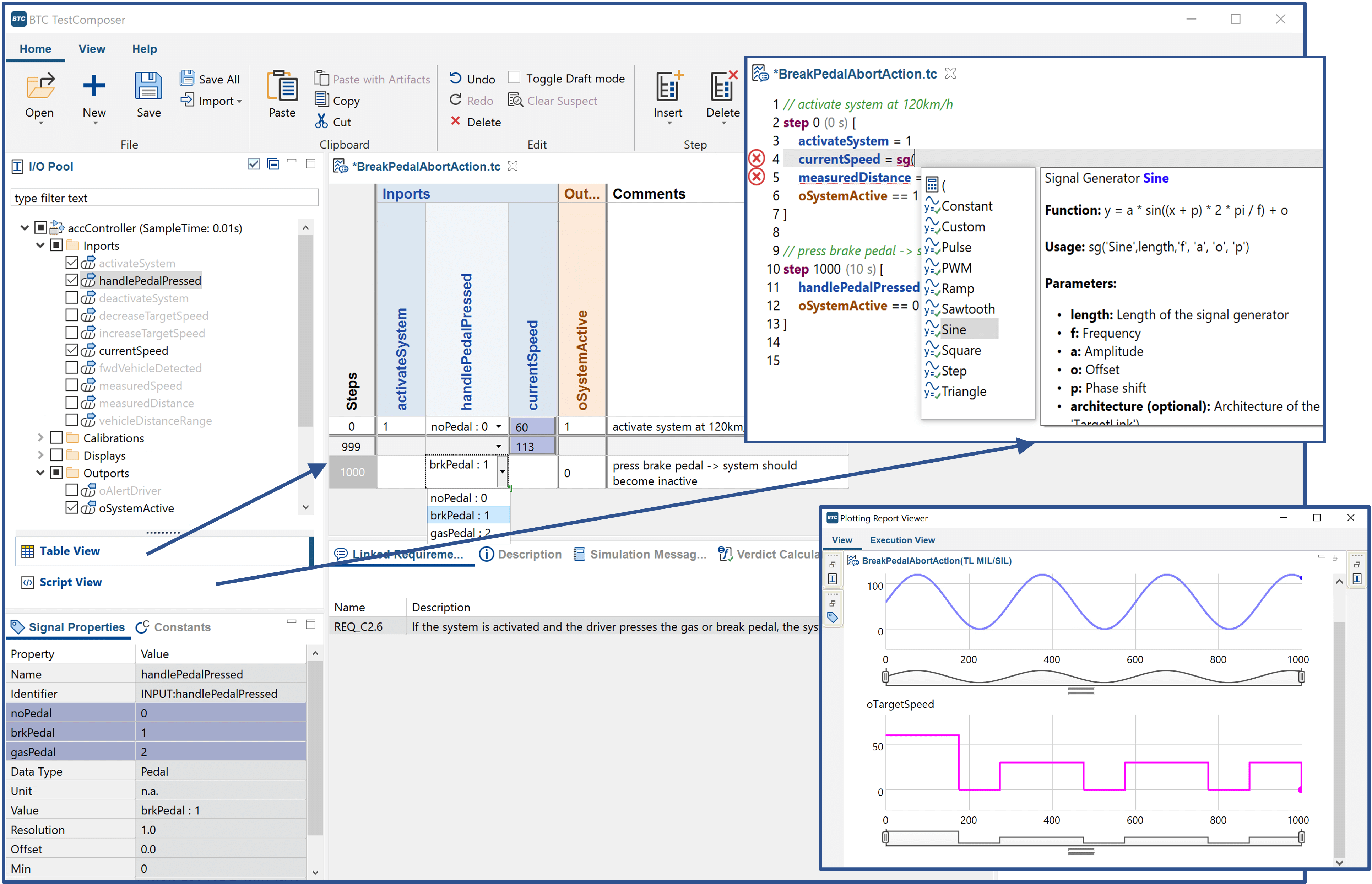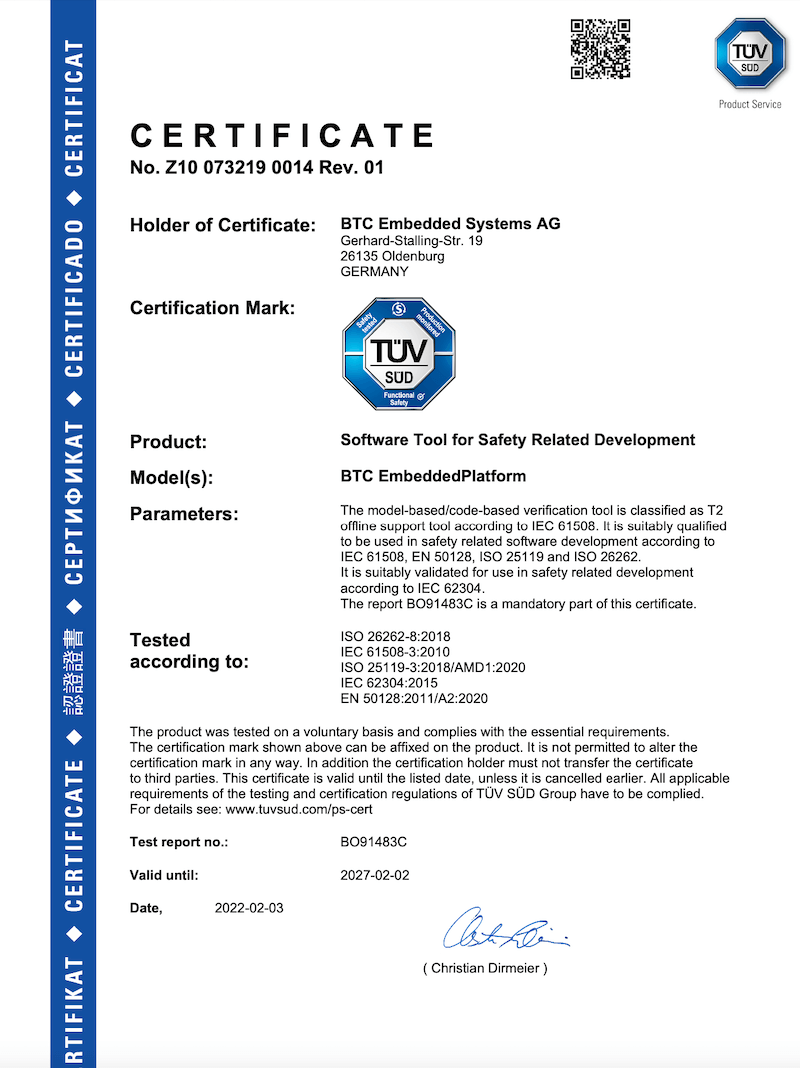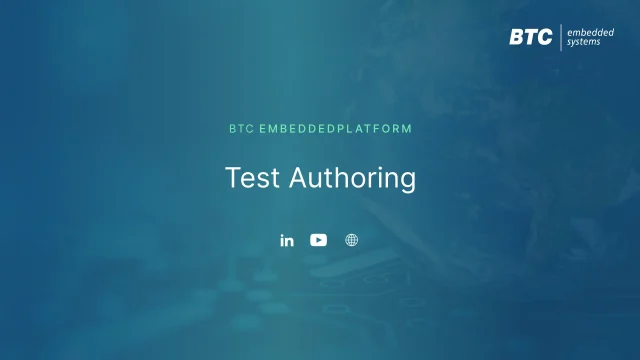Close

Requirements-based testing for Simulink, TargetLink, Embedded Coder and handwritten code
BTC EmbeddedTester BASE is an ISO 26262 certified tool for creating, managing and executing test cases on model and code level (MIL/SIL/PIL).
Requirements-based testing (sometimes also called functional testing) is typically a very time consuming task. Not only because test cases need to be derived from the requirements, but more importantly because topics like traceability, coverage analysis or creating a test harness are a real challenge which often leads to a collection of tools which are not well integrated.
Features like the tight integration with your development environment, built-in connection to requirements management tools or the integrated coverage analysis make BTC EmbeddedTester BASE your one-stop solution for Requirements-based testing of models and production code.
A direct API connection to (ALM/PLM) requirements management tools (including IBM DOORS, PTC Integrity or Siemens Polarion) ensures reliable traceability of requirements, while avoiding error prone exchange formats like Excel or ReqIF.
In addition to requirements, it is even possible to synchronize test cases and simulation results for accessing test status information on project level directly in our ALM/PLM tool.
In case a requirement gets modified, BTC EmbeddedTester BASE will highlight the requirement as well as the linked test cases. A powerful DIFF view allows the user to examine the changes and update the test cases if needed.
In our experience, test cases are too often written in languages which were not designed for that purpose. Examples are scripting languages like Matlab or Python, Excel tables or even C code.
With BTC TestComposer we provide a powerful editor for functional test cases directly within BTC EmbeddedTester BASE. BTC TestComposer knows all details about the test architecture and protects users against invalid data entry. If enumerations are used, a drop-down menu is provided and allows to directly select the desired values.
Further features include a signal generator, a graphical viewer, flexible tolerance handling and a formula editor, allowing us to calculate the value of a certain signal based on other variables. “Test Macros” and “Calibration Sets” can be used to specify and store reusable sequences, and can be instantiated in multiple test cases. This makes it possible to execute test cases directly within the editor and immediately visualize the results.

The requirements coverage report shows, if all requirements are covered by test cases and if the linked test cases are passed on the different execution levels MIL, SIL and PIL
The model coverage report documents the achieved coverage of a Simulink/Stateflow models. If test cases exist on different subsystem levels of a larger models, the coverage metrics are automatically aggregated for the higher hierarchy levels
Code coverage is automatically calculated and updated in the background. Create, change, import, or delete a test case? The code coverage report has already been updated to reflect these changes.
As modern model-based development projects grow in complexity, the task of debugging failed test cases becomes increasingly challenging and time consuming. Even more challenges emerge in situations when the function development and testing are separated and performed by different people or different teams. This leads us to an important question: What is the most efficient way for the test engineer provide his test scenario to the developer?
BTC EmbeddedTester BASE includes a unique debugging approach by generating self-contained sandboxes. These sandboxes contain a copy of the system-under-test as well as the test case incl. the corresponding calibration values. Depending on the use case, this sandbox can either be a Simulink model, a Microsoft Visual Studio project file or a generic code-based sandbox for other IDEs. These sandboxes can be easily shared with colleagues or customers and make it easy to try out modifications without harming the original files.


BTC EmbeddedPlatform (incl. BTC EmbeddedTester BASE, BTC EmbeddedTester, BTC EmbeddedSpecifier and BTC EmbeddedValidator) has been certified by German TÜV Süd as fit for usage in safety critical software development projects.
The certificate addresses different standards including IEC 61508-3:3010, ISO 26262, EN 50128, IEC 62304 as well as ISO 25119.
For the automotive standard ISO 26262, we have been certified with the highest tool confidence level TCL and the certificate is valid for all ASIL levels including ASIL D.
We provide the certificate and the corresponding report to our customers free of charge upon request, which almost eliminates any effort for tool qualification measures on the customer side.

If you would like to try out our tools, we will gladly provide an evaluation license free of charge. Evaluations include a free launch workshop and also provide an opportunity for you to meet one-on-one with our support and engineering teams.
Do you have any questions or want to see our tools in action? If so, please use the link below to schedule a meeting, where a member of our engineering team will be happy to show you the features and use cases and directly answer any questions you might have.
If you would like to try out our tools, we will gladly provide an evaluation license free of charge. Evaluations include a free launch workshop and also provide an opportunity for you to meet one-on-one with our support and engineering teams.
Do you have any questions or want to see our tools in action? If so, please use the link below to schedule a meeting, where a member of our engineering team will be happy to show you the features and use cases and directly answer any questions you might have.
Discover some of the main features of our products in these short videos.




Intelligent test generation for automated Back-to-back tests, Regression tests and Migration tests
We provide intelligent and automated test solutions which enable our customers to deal with the growing complexity of embedded software while achieving high quality in compliance with the ISO 26262 standard.
Copyright © 2025 BTC Embedded Systems